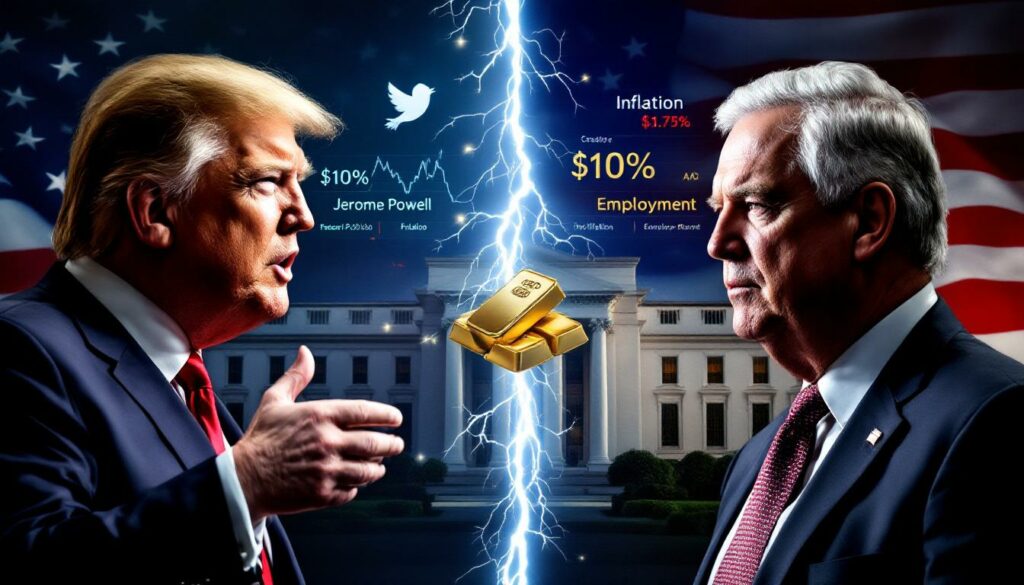What's Behind the Trump-Powell Tensions?
The relationship between a U.S. president and the Federal Reserve Chair has always been complex, but the tensions between former President Donald Trump and Fed Chair Jerome Powell reached unprecedented levels. These tensions represent a fundamental clash between political priorities and monetary independence that continues to influence financial markets and economic policy debates.
At the heart of these tensions lies an extraordinary financial challenge: approximately $10 trillion in U.S. debt requiring refinancing, as highlighted by market analyst Peter Grandich. This massive refinancing need created a fundamental conflict between Trump's desire for lower interest rates and Powell's mandate to control inflation, which had shown two consecutive monthly increases by mid-2025.
"Trump is under the belief that he can magically lower rates without penalty… the big penalty would be in the dollar," noted Grandich during a July 2025 interview with Palisades Gold Radio, highlighting the economic reality that contradicted political wishful thinking.
The Historical Context of Fed Independence
The Federal Reserve was designed to operate independently from political pressure, allowing it to make monetary policy decisions based on economic data rather than political expediency. This independence has been respected to varying degrees by different administrations, but the Trump era saw this relationship significantly tested.
The Fed's structure intentionally includes 14-year terms for governors to insulate them from short-term political pressures. This design reflects lessons learned from historical periods when central banks lacked independence, resulting in economic instability and inflationary spirals.
Trump's Economic Priorities vs. Powell's Mandate
Trump's administration prioritized stock market performance and GDP growth as indicators of economic success. His approach often favored:
- Lower interest rates to stimulate borrowing and economic activity
- Accommodative monetary policy to support market valuations
- Short-term economic boosts that could translate to political capital
"The stock market is Trump's Good Housekeeping Seal – his entire image is tied to it," observed Grandich, explaining Trump's fixation on market performance as a validation of his presidency.
Powell, meanwhile, was focused on the Fed's dual mandate of:
- Maintaining price stability (controlling inflation)
- Supporting maximum sustainable employment
- Ensuring long-term economic stability
The conflict was exacerbated by complex economic factors like US debt and tariffs. As Grandich explained, Trump's 50% tariffs on commodities like copper eventually showed up in Consumer Price Index (CPI) figures but not in Producer Price Index (PPI) data, creating inflation mismatches that complicated the Fed's decision-making process.
How Did the Tensions Manifest Publicly?
The Trump-Powell relationship deteriorated in several notable ways that impacted market sentiment and raised questions about central bank independence.
Public Criticism and Social Media Pressure
Trump broke with presidential tradition by openly criticizing the Federal Reserve Chair through:
- Direct social media commentary on interest rate decisions
- Public statements questioning Powell's competence
- Suggestions that he had the authority to remove Powell from his position
The public nature of these criticisms represented a significant departure from historical norms. Previous presidents typically avoided public comments on Fed policy to maintain market stability and respect institutional boundaries.
"Trump broke with tradition by openly criticizing the Fed Chair… markets tanked within minutes of firing rumors," noted Grandich, describing the immediate market reactions to what had previously been considered taboo in presidential behavior.
The Interest Rate Battleground
At the heart of the conflict was disagreement over interest rate policy:
- Trump consistently pushed for lower rates to stimulate economic growth
- Powell and the FOMC (Federal Open Market Committee) initially raised rates to normalize policy after years of near-zero rates
- Market volatility often followed public disagreements between the two
The dispute was complicated by real economic challenges. By mid-2025, the U.S. faced approximately $50 trillion in total debt. With interest rates around 5%, the annual interest payment alone approached $2.5 trillion—nearly half of the government's peak annual revenue of $6 trillion, according to Grandich's analysis.
The Firing Speculation
Perhaps the most dramatic manifestation of the tensions came with recurring speculation that Trump might attempt to fire Powell, despite legal questions about whether a president has this authority.
Gold surged $50 within minutes of rumors about Powell's potential firing in July 2025, while stock markets declined concurrently. This dramatic market reaction demonstrated how seriously investors took the threat to Fed independence.
The legal ambiguity surrounding a president's power to remove a Fed chair added to market uncertainty. While the Federal Reserve Act states governors can only be removed "for cause," this provision has never been fully tested in court, leaving open questions about presidential authority in this area.
What Were the Market Implications of These Tensions?
The ongoing conflict between Trump and Powell created several notable market effects that investors had to navigate.
Volatility Triggers
Markets became highly sensitive to the Trump-Powell relationship:
- Stock markets would often decline on news of potential Fed Chair dismissal
- Gold prices would surge during periods of heightened tension
- Bond markets would react to changing expectations about Fed independence
"Gold is a barometer of tensions… it's a hedge against monetary policy uncertainty," explained Grandich. This relationship was dramatically demonstrated when gold prices jumped $50 within minutes of rumors about Powell's firing, serving as a real-time indicator of market concerns about central bank independence.
The volatility extended beyond precious metals. Uranium equities saw a 70% surge between April and July 2025 in Grandich's portfolio, reflecting both sector-specific developments and broader moves toward alternative investments during periods of monetary uncertainty.
Investor Sentiment Shifts
The tensions created a complex environment for investors:
- Uncertainty about monetary policy direction increased risk premiums
- Some investors positioned for more accommodative policy based on presidential pressure
- Others worried about long-term inflation risks if Fed independence was compromised
Grandich highlighted a critical structural change affecting market reactions: "Passive investing dominates markets: 50%+ of trading tracks indexes, not fundamentals." This shift amplified market movements, as fewer active managers were making decisions based on the economic implications of the Trump-Powell tensions.
Dollar Strength Considerations
The relationship had significant implications for the U.S. dollar:
- Dollar strength was affected by changing perceptions of Fed independence
- International investors watched the tensions for signs of monetary policy shifts
- Currency markets factored in political risk premiums during periods of heightened conflict
The potential for dollar weakness became a central concern. As Grandich warned, "The big penalty [of politically-driven rate cuts] would be in the dollar." This concern was amplified by concurrent developments like BRICS expansion, with over 40 countries considering membership in mid-2025, potentially accelerating de-dollarization trends.
Why Does Central Bank Independence Matter?
The Trump-Powell tensions highlighted fundamental questions about the importance of central bank independence in modern economies.
Economic Stability Concerns
Central bank independence serves several critical functions:
- Allows monetary policy to focus on long-term economic stability rather than short-term political goals
- Helps maintain credibility with international markets and investors
- Provides a counterbalance to political spending pressures
"Removing Powell would signal banana republic economics… it's about perception overseas," Grandich warned. This concern about international perception becomes especially critical when considering the need to finance approximately $10 trillion in U.S. debt refinancing.
The concentration of wealth adds another dimension to these concerns. With 86% of U.S. assets owned by the top 10% wealthiest Americans (according to Grandich citing wealth inequality data), monetary policy decisions increasingly affect different segments of society in drastically different ways.
Historical Lessons
Countries with less independent central banks have historically experienced:
- Higher and more volatile inflation rates
- Greater economic instability
- More frequent financial crises
- Less credibility in international markets
These lessons from economic history informed the Federal Reserve's design, with governors serving staggered 14-year terms specifically to insulate them from political pressure. The Trump-Powell tensions tested whether these structural protections remained sufficient in an era of instantaneous communication and unprecedented political polarization.
Institutional Credibility
The Fed's effectiveness depends largely on market confidence:
- Markets must believe the Fed will act based on economic data, not political pressure
- Credibility allows the Fed to influence markets through communication and expectations
- Loss of independence could reduce monetary policy effectiveness
The threat to institutional credibility extends beyond monetary policy. As Grandich observed, "Small businesses—America's backbone—get ignored while Trump focuses on corporate deals." This disconnect highlights broader concerns about whether policy decisions are being made to benefit the entire economy or just its most visible segments.
How Did Financial Markets React to the Tensions?
The financial markets developed specific response patterns to the Trump-Powell relationship dynamics.
Gold as a Barometer
Gold prices became a key indicator of tensions:
- Price surges often followed public criticism of Powell
- Gold functioned as a hedge against potential monetary policy uncertainty
- Investors used gold as protection against possible inflation from politically-driven monetary policy
The July 2025 episode where gold jumped $50 within minutes of Trump-Powell conflict rumors demonstrated the metal's role as an immediate barometer of institutional confidence. As Grandich explained, physical gold demand from central banks provided structural support, highlighting gold's role in the global monetary system beyond just U.S. domestic politics.
In fact, the record gold highs analysis from mid-2025 showed that institutional concerns about central bank independence were a key driver of price movements, alongside traditional factors like inflation expectations and currency dynamics.
Equity Market Volatility
Stock markets showed distinct patterns:
- Initial negative reactions to threats against Fed independence
- Subsequent rallies when accommodative policy seemed more likely
- Sector rotation based on changing interest rate expectations
The equity market reaction revealed a complex dynamic where long-term concerns about institutional stability competed with short-term excitement about potential monetary stimulus. This tension was amplified by the dominance of passive investing, with Grandich noting that over 50% of trading tracked indexes rather than responding to fundamental economic analysis.
Bond Market Signals
The fixed income markets provided important insights:
- Yield curve movements reflected changing expectations about Fed policy
- Long-term bonds often signaled concerns about future inflation
- Short-term rates reflected immediate policy expectations
The bond market faced particular challenges from the Trump-Powell tensions due to the massive refinancing needs of U.S. government debt. With approximately $10 trillion requiring refinancing, even small changes in interest rates driven by political pressure rather than economic conditions could have outsized impacts on government finances.
What Were the Legal Boundaries of Presidential Authority?
The tensions raised important questions about the legal framework governing the Federal Reserve.
Federal Reserve Act Provisions
The Federal Reserve's structure includes specific protections:
- Fed governors serve 14-year terms specifically to insulate them from political pressure
- The Chair serves a 4-year term that doesn't align with presidential terms
- Removal is legally limited to "cause" rather than policy disagreements
The ambiguity around what constitutes "cause" for removal became a central legal question. While misconduct would clearly qualify, the law remains untested on whether policy disagreements could justify removal of a Fed chair, creating uncertainty that markets had to price into risk assessments.
Historical Precedents
Previous tensions between presidents and Fed chairs never reached the same level:
- No modern president had openly threatened to fire a Fed chair
- Past disagreements were typically handled through private channels
- Public criticism was generally avoided to maintain market stability
The Trump-Powell relationship represented a break from historical norms that had evolved precisely to protect market stability and institutional credibility. This unprecedented nature of the conflict left markets without clear historical analogues to guide expectations.
Constitutional Questions
The conflict raised unresolved constitutional questions:
- The extent of presidential authority over independent agencies
- The definition of "cause" for removal of a Fed chair
- The role of Congress in protecting Fed independence
These constitutional questions remained largely theoretical until the Trump-Powell tensions brought them to the forefront of market concerns. The lack of clear judicial precedent on these issues added another layer of uncertainty to an already complex relationship.
How Did This Compare to International Central Bank Relationships?
The Trump-Powell tensions stood in contrast to central bank relationships in other major economies.
European Central Bank Independence
The ECB operates under different conditions:
- Multiple member countries create natural insulation from any single political influence
- Stronger statutory independence provisions
- Different cultural expectations about central bank autonomy
The ECB's multinational structure provides inherent protection against the kind of direct political pressure seen in the Trump-Powell relationship. This structural difference became increasingly relevant as markets compared the stability of different monetary regimes.
Bank of Japan Dynamics
Japan offers an interesting comparison:
- Historically closer relationship between government and central bank
- Different approach to monetary policy coordination
- Similar challenges balancing political priorities with monetary stability
Grandich noted that even with Japan's different approach to central bank independence, market forces still asserted themselves, with Japanese bond yields rising despite negative-rate policies. This observation highlighted how market discipline operates across different institutional arrangements.
Bank of England Framework
The UK system provides another contrast:
- Clear operational independence but with government-set inflation targets
- More formalized communication protocols between government and central bank
- Different accountability mechanisms
The more structured relationship between the UK government and the Bank of England demonstrates an alternative approach to balancing democratic accountability with monetary independence, offering potential lessons for improving the U.S. framework.
What Long-Term Effects Emerged From These Tensions?
The Trump-Powell relationship may have lasting implications for U.S. monetary policy and central banking.
Institutional Safeguards
The experience prompted discussions about:
- Whether additional legal protections for Fed independence are needed
- How communication between the White House and Fed should be structured
- The role of Congress in protecting central bank independence
The unprecedented nature of the tensions exposed potential weaknesses in the institutional framework that had previously been considered adequate. This prompted serious consideration of whether formal communication protocols or additional statutory protections might be necessary.
Market Psychology
Investor behavior adapted to the new dynamics:
- Greater attention to political factors in monetary policy expectations
- Increased hedging against policy uncertainty
- More sophisticated analysis of the politics-monetary policy relationship
Grandich advised investors to "Diversify into inflation hedges: gold, TIPS, commodities" as a response to the new monetary-political landscape. This shift in investment approach reflected a broader adaptation to a world where central bank independence could no longer be taken for granted.
Policy Framework Evolution
The Fed itself responded to the pressures:
- Greater transparency about decision-making processes
- More robust communications about the importance of independence
- Evolution in how policy decisions are explained to the public and politicians
These adaptations represented efforts to strengthen the Fed's position through increased transparency and public education rather than simply relying on traditional institutional boundaries that had proven vulnerable to unprecedented political pressure.
How Should Investors Navigate Political-Monetary Tensions?
The Trump-Powell relationship offers important lessons for investors dealing with similar dynamics in the future.
Diversification Strategies
Prudent approaches include:
- Maintaining exposure to assets that perform differently under various monetary policy scenarios
- Including inflation hedges like gold, TIPS, and certain commodities
- Geographic diversification to reduce exposure to any single central bank's policies
Grandich specifically recommended physical metals as "insurance" (5-10% allocation) in portfolios. For those considering mining equities, he emphasized diversification due to high failure rates in junior mining companies, noting one successful example that rose from 12¢ to 46¢ (a 300% gain) in his portfolio.
The historic gold surge explanation provided by analysts highlighted how fundamental factors combined with geopolitical and monetary policy tensions to drive unprecedented price movements, underscoring gold's continued role as a monetary policy hedge.
Signal Identification
Investors can watch for key signals:
- Changes in the tone of communications between political leaders and central bankers
- Market reactions to political comments about monetary policy
- Shifts in central bank communication styles during periods of political pressure
The gold price reaction to Trump-Powell tensions provided a clear example of such signaling, with immediate price jumps reflecting market concerns about institutional stability. These market movements offer real-time feedback on the perceived severity of political-monetary conflicts.
Long-Term Perspective
The experience reinforces the importance of:
- Looking beyond short-term market reactions to political-monetary tensions
- Understanding the historical importance of central bank independence
- Recognizing that institutional frameworks generally prevail over individual conflicts
"Watch BRICS—they're building an alternative to the U.S.-centric system," warned Grandich, highlighting how domestic political-monetary tensions could accelerate international trends toward alternatives to dollar dominance. This observation connects domestic institutional conflicts to broader geopolitical shifts in the global monetary order.
Furthermore, ongoing US–China trade tensions continued to influence both monetary policy considerations and market dynamics, creating additional layers of complexity for investors attempting to navigate the Trump-Powell relationship.
What Can We Learn From the Trump-Powell Tensions?
The relationship between these two powerful figures offers broader insights about monetary policy, politics, and markets.
Institutional Resilience
Despite unprecedented tensions:
- The Federal Reserve maintained its independence in policy decisions
- Markets ultimately distinguished between political rhetoric and actual policy
- The institutional framework proved relatively robust
The resilience of the Federal Reserve as an institution, despite unprecedented political pressure, demonstrated the strength of its underlying structure. However, the tensions also revealed vulnerabilities that may require attention to preserve independence in future conflicts.
Communication Importance
The episode highlighted how critical communication has become:
- Market reactions often responded more to communication than actual policy changes
- Inconsistent messaging created unnecessary volatility
- Clear, consistent communication helps maintain stability during periods of tension
The immediate market reactions to rumors and statements demonstrated the power of communication in modern markets. This heightened sensitivity increases the responsibility of both political leaders and central bankers to consider the market impact of their words.
Balance of Powers
The tensions revealed the complex balance in the
Ready to Capitalise on the Next Mineral Discovery?
Discover significant ASX mineral discoveries the moment they happen with Discovery Alert's proprietary Discovery IQ model, providing real-time alerts and actionable insights for investors. Visit our discoveries page to explore how historic mineral discoveries have generated exceptional returns and start your 30-day free trial today.




